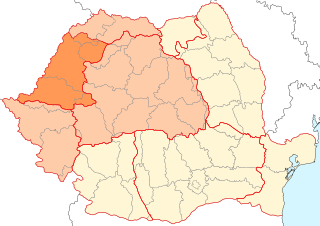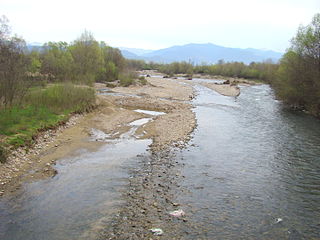
Bihor County is a county (județ) in western Romania. With a total area of 7,544 km2 (2,913 sq mi), Bihor is Romania's 6th largest county geographically and the main county in the historical region of Crișana. Its capital city is Oradea.

Aleșd is a town in Bihor County, western Romania. It administers three villages: Pădurea Neagră (Feketeerdő), Peștiș (Sólyomkőpestes), and Tinăud (Tinód).

Crișana is a geographical and historical region in north-western Romania, named after the Criș (Körös) River and its three tributaries: the Crișul Alb, Crișul Negru, and Crișul Repede. In Romania, the term is sometimes extended to include areas beyond the border, in Hungary; in this interpretation, the region is bounded to the east by the Apuseni Mountains, to the south by the Mureș River, to the north by the Someș River, and to the west by the Tisza River, the Romanian-Hungarian border cutting it in two. However, in Hungary, the area between the Tisza River and the Romanian border is usually known as Tiszántúl.

The Körös or Criș is a river in eastern Hungary and western Romania. Its length is 128.6 km (79.9 mi) from the confluence of its two source rivers Fehér-Körös and Fekete-Körös to its outflow into the Tisza. Its drainage basin area is 27,537 km2 (10,632 sq mi). It has three source rivers, all with their origin in the Apuseni Mountains in Transylvania, Romania: Crișul Alb (Fehér-Körös), Crișul Negru (Fekete-Körös) and Crișul Repede (Sebes-Körös). The confluence of the rivers Fehér-Körös and Fekete-Körös is near the town Gyula. The Körös downstream from Gyula is also called the Kettős-Körös. 37.3 km further downstream, near Gyomaendrőd, the Sebes-Körös joins the Körös/Criș. The section downstream from Gyomaendrőd is also called the Hármas-Körös. The Körös flows into the Tisza River near Csongrád.

Aștileu is a commune in Bihor County, Crișana, Romania. It is composed of four villages: Aștileu, Călățea (Kalota), Chistag (Keszteg), and Peștere (Körösbarlang).

The Crișul Alb (Romanian), is a river in western Romania, in the historical region of Transylvania, and in south-eastern Hungary.
Criș may refer to several places:

The Crișul Negru (Romanian), is a river in western Romania (Transylvania) and south-eastern Hungary. The river has its source in the western Apuseni Mountains of Romania. Flowing through the Romanian towns of Ștei and Beiuș and crossing the border of Hungary, the river, now called Fekete-Körös, joins the Fehér-Körös a few kilometres north from Gyula to form the Körös river. In Romania, its length is 164 km (102 mi) and its basin size is 3,820 km2 (1,470 sq mi). Part of the water from the river Crișul Repede is diverted towards the Crișul Negru by the Criș Collector Canal.

Negreni is a commune in Cluj County, Transylvania, Romania. It is composed of three villages: Bucea (Királyhágó), Negreni and Prelucele (Prelak). These were part of Ciucea Commune from 1968 to 2002, when they were split off.

Remetea is a commune in Bihor County, Crișana, Romania. It is composed of five villages: Drăgoteni (Drágota), Meziad (Mézged), Petreasa (Petrász), Remetea, and Șoimuș (Gyepüsolymos).

Roșia is a large commune in Romania, Crișana, Bihor County, around 21 kilometres north from the town of Beiuș. It is composed of two villages, Lazuri (Lázurihegy) and Roșia.

The Valea Roșie or Roșia is a river in Romania, Bihor County, right tributary of the Crișul Negru. Its length is 38 km (24 mi) and its basin size is 308 km2 (119 sq mi).
The Iad is a left tributary of the river Crișul Repede in Romania. It discharges into the Crișul Repede near Bulz. Its length is 46 km (29 mi) and its basin size is 220 km2 (85 sq mi).

The Crișul Pietros is a right tributary of the river Crișul Negru in Romania. Upstream from its confluence with the Boga it is called Valea Galbena. Its length is 31 km (19 mi) and its basin size is 226 km2 (87 sq mi). It discharges into the Crișul Negru in Drăgănești.

The Barcău or Bereteu is a river which has its origin in Sălaj County, Romania. It is about 167 kilometres (104 mi) long with a watershed area of 5,812 km2 (2,244 sq mi). After crossing Bihor County in Romania and Hajdú-Bihar and Békés County in Hungary, it flows into the Sebes-Körös near Szeghalom. Its length in Romania is 134 km (83 mi).

Bulz is a commune in Bihor County, Crișana, Romania with a population of 1,903 as of 2021. It is composed of three villages: Bulz, Munteni, and Remeți (Jádremete).

Cărpinet is a commune in Bihor County, Crișana, Romania with a population of 1,607 people as of 2021. It is composed of four villages: Călugări (Kalugyer), Cărpinet, Izbuc (Vaskohszohodol), and Leheceni (Lehecsény).

Oșorhei is a commune in Bihor County, Crișana, Romania with a population of 8,536 people as of 2021. It is composed of five villages: Alparea (Váradalpár), Cheriu (Alkér), Felcheriu (Felkér), Fughiu (Fugyi), and Oșorhei.

Uileacu de Beiuș is a commune in Bihor County, Crișana, Romania. It is composed of four villages: Forău (Belényesforró), Prisaca (Gyepüpataka), Vălanii de Beiuș (Belényesvalány), and Uileacu de Beiuș.
The Criș Collector Canal is the main canal of the drainage system of the area between the Crișul Repede and the Crișul Negru in Bihor County, western Romania. The lower reach of the canal is also known as Tămașda Collector Canal.





















